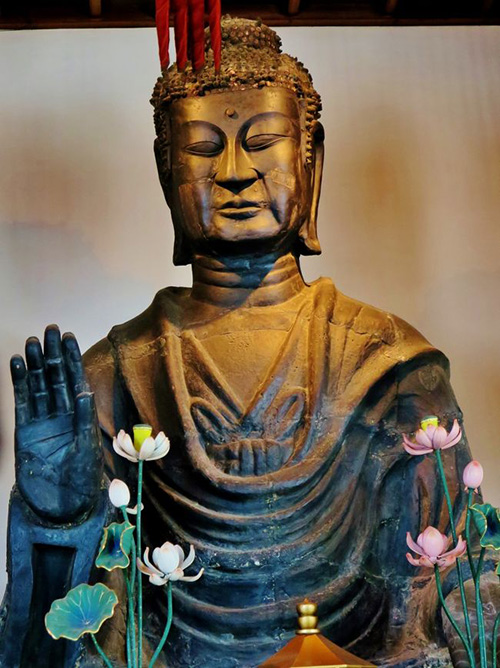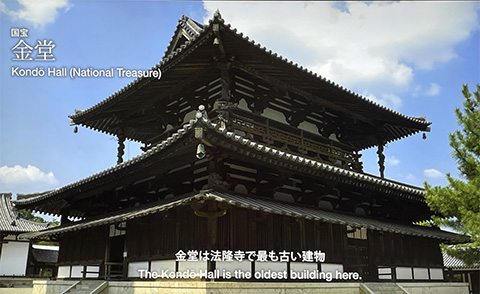

奈良の東大寺大仏など公開されているものもあるけれど、法隆寺の本尊仏像というのはわたしは見たことがなかった。なんとなくボーッと見ていたのか(笑)。一方で飛鳥寺では本堂に入ったらすぐに「飛鳥大仏」さんが迎えてくれる。気軽に迎えてくれる感じで、止利仏師作と伝わるその表情がなんとも言えずに好きになった。で、今回デジタル法隆寺宝物館展示で、紹介されていた「釈迦三尊像」の中心の仏様の表情を見てこちらも、やはり止利仏師作という説に審美眼的に確信を持てた次第。
なにがどうとは言えないけれど全体としての雰囲気に共通性を感じさせられる。やはり顔の造作、作られよう、バランス感覚的に共通項がきわめて多く、親和性を感じる。
写真上が釈迦三尊で下が飛鳥大仏。飛鳥大仏の方が先に作られその評判から、同じ制作者に発注されたのかと推測できる。止利仏師は鞍作鳥という名前の示すとおり、本来は乗馬用の鞍の制作がかれの本業だったそうだが、仏教伝来期の専門家不足からなのか、その制作レベルの高さを見込まれ、あるいはむしろこの仕事のために半島から移住したかして、これらの仏像制作に当たったとされてきた。
この国家事業の発注責任者だった聖徳太子自身がその仏像モデルではないかというのが一般的な通説。だとすれば、飛鳥寺大仏も聖徳太子の支援者であった「蘇我氏」によって造営された最初期の仏教寺院とされるので符合する部分があるのでしょうか。

飛鳥寺の創建は596年。593年に聖徳太子が推古天皇の摂政となり、その後法隆寺の創建は607年。
この時代の大きな動乱としては587年7月の崇仏派と排仏派の戦いがある。崇仏派の蘇我馬子は排仏派の物部守屋追討軍を派遣して厩戸皇子(聖徳太子)などの皇族や諸豪族の軍兵を率いて河内国渋川郡の守屋の館へ進軍しこれを討ち果たした。この結果、仏教導入が国策決定し飛鳥寺、四天王寺、法隆寺などの国家的寺院建設事業が旺盛に始められることになった。
この時代、事実上仏教が世界宗教として隆盛し同時にアジア世界に強大な隋・唐の統一国家が出現したことに対応して、崇仏派はその世界共通思想基盤としての仏教を国策導入しようとしたのだと思う。
外圧に対して対抗していくには積極的に導入して対外関係を強固にすべきという勢力。一方で既存の分権的国家でいいと考える勢力・物部氏一派との対立だったのか。その後の日本の歩みを見てもこういう政治選択・二元論は常にあった。
こうして国内争闘に勝利した崇仏派であった聖徳太子だが、一方かれが派遣した遣隋使・小野妹子に日本は隋と同等国であるとしたたかに宣命させる。「日出る処の天子、書を日没する処の天子に致す。つつがなきや」と。隋の皇帝はその不逞な態度に怒ったとされるが、国際関係では高句麗対応の必然性もあって事実経緯としては日本の独立性は尊重された。外交的には勝利を得たと言えるだろう。
開明派でありながら、外交では独立対等外交にこだわったのだ。むしろこのあたりが聖徳太子が長く日本人に愛され崇拝されてきた大きな理由なのではないか。大陸国家に対してどう向き合うのか、それがいまに至るも日本という国のアイデンティティの骨格部分なのかも知れない。
English version⬇
Two Buddhist Statues Modeled after Shotoku Taishi? Two Buddhist statues, The Gallery of Horyuji Treasures-3
Two of the earliest works in the art genre of Buddhist statues in Japan. The admiration for their models. The role they played in imprinting the teachings of Buddhism on the minds of the Japanese people. The role they played in imprinting the teachings of Buddhism in the hearts of the Japanese people.
Some of the statues, such as the Great Buddha of Todaiji Temple in Nara, are open to the public, but I had never seen the main statue of Buddha at Horyuji Temple. I guess I was just kind of staring at it in a daze (laughs). On the other hand, in Asukadera Temple, you are greeted by the “Great Buddha of Asuka” as soon as you enter the main hall. I felt welcomed easily, and I liked the expression on his face, which is said to have been made by Buddhist priest Toributsuji. And when I saw the expression of the Buddha in the center of the “Shakyamuni Sanzon Zo” that was on display at the Digital Gallery of Horyuji Treasures, I was aesthetically convinced that it was also made by the master.
I cannot say what it is about the statues, but the overall atmosphere of the statues is similar. The facial features, the way they are made, and the sense of balance have a lot in common, and I feel a sense of affinity with them.
The upper photo shows the three images of Shakyamuni and the lower photo shows Asuka Daibutsu. The Asuka Daibutsu was built before the Shakyamuni Buddha, and its reputation leads us to assume that the same creator was commissioned to make the Asuka Daibutsu. As the name “Kurazakudori” suggests, the original saddle maker’s main occupation was to make saddles for horseback riding, but it is said that he was expected to produce these Buddhist statues because of the shortage of specialists during the period of the arrival of Buddhism, or because of his high level of production, or rather because he emigrated from the peninsula to do this work.
The general consensus is that Prince Shotoku himself, who was in charge of ordering this national project, may have been the model for these Buddhist statues. If so, is there a point of coincidence since the Asukadera Great Buddha is also considered to be the first Buddhist temple built by the “Soga clan,” which was a supporter of Prince Shotoku?
Asuka-ji Temple was built in 596; Prince Shotoku became regent of Emperor Suiko in 593, and Horyu-ji Temple was built later in 607.
One of the major upheavals of this period was the battle between the Chūbutsu and Exclusionist factions in July 587. Soga Umako, a member of the Chūbutsu faction, dispatched an army to defeat Mononobe Moriya, a member of the Zeng-butsu faction, and led a military force of the Imperial Family, including Prince Umamado (Prince Shotoku) and other powerful clansmen, to Moriya’s mansion in Shibukawa County, Kawachi Province. As a result, the introduction of Buddhism became a national policy, and national temple construction projects such as Asukadera, Shitennoji, and Horyu-ji were vigorously undertaken.
In this period, Buddhism virtually flourished as a world religion, and at the same time, the powerful united states of Sui and Tang appeared in the Asian world.
The Chongbulists believed that in order to oppose external pressure, they should actively introduce Buddhism to strengthen their foreign relations. On the other hand, was this a confrontation between the Mononobe clan and those who thought that the existing decentralized state was sufficient? Looking at Japan’s subsequent history, this kind of political choice and dualism has always existed.
Prince Shotoku, who was a member of the Chōbutsu faction, was thus victorious in the domestic struggle, but he had his envoy to the Sui Dynasty, Ono Imoko, declare that Japan was a nation on par with the Sui Dynasty. The Prince of Heaven where the sun rises and the book is given to the Prince of Heaven where the sun sets. This will be done without fail. The Sui Dynasty emperor is said to have been angered by this intransigent attitude, but in international relations, Japan’s independence was respected as a matter of fact, partly due to the necessity of dealing with the Goguryeo Dynasty. Diplomatically, it can be said that Japan won a victory.
Although he was an open-minded man, he insisted on independent and equal diplomacy in foreign affairs. In fact, this may be a major reason why Prince Shotoku has long been loved and worshipped by the Japanese people. How to deal with a continental nation may be the backbone of Japan’s identity to this day.
Posted on 5月 31st, 2023 by 三木 奎吾
Filed under: 歴史探訪







コメントを投稿
「※誹謗中傷や、悪意のある書き込み、営利目的などのコメントを防ぐために、投稿された全てのコメントは一時的に保留されますのでご了承ください。」
You must be logged in to post a comment.